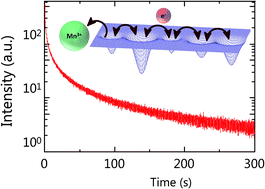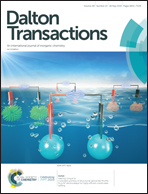A stochastic analysis based on a one-dimensional random walk model of the persistent phosphorescence of Mn2+ ions doped in zinc magnesium phosphate†
Abstract
We investigate the mechanism of the persistent phosphorescence (PP) of β-Zn3(PO4)2:Mn2+ and γ-(Zn2+,Mg2+)3(PO4)2:Mn2+ systems via stochastic analysis. An electron hopping mechanism, recombining electrons with Mn3+ ions, is proposed to elucidate the long-tailed decay feature that represents a non-exponential decay curve for the PP intensity change over time. A simulation using a one-dimensional random walk for the electron hopping in the host material successfully reproduces the PP decay curve. In the simulation, electrons, as charge carriers, are obliged to move on by a number of linearly ordered traps, to step forward or backward to the next trap with a probability of 1/2, and to keep hopping until reaching the emitting center. Furthermore, we present simulations of PP results depending on the temperature, Mn2+ ion concentration in β-Zn3(PO4)2:Mn2+, and crystal lattice size in γ-(Zn2+,Mg2+)3(PO4)2:Mn2+. These results allow us to know that the length of the trap array can control the features of the PP time profile. Consequently, we conclude that a large number of patterns for electron hopping that recombine electrons with Mn3+ ions are responsible for the long-tailed PP decay curve.



 Please wait while we load your content...
Please wait while we load your content...